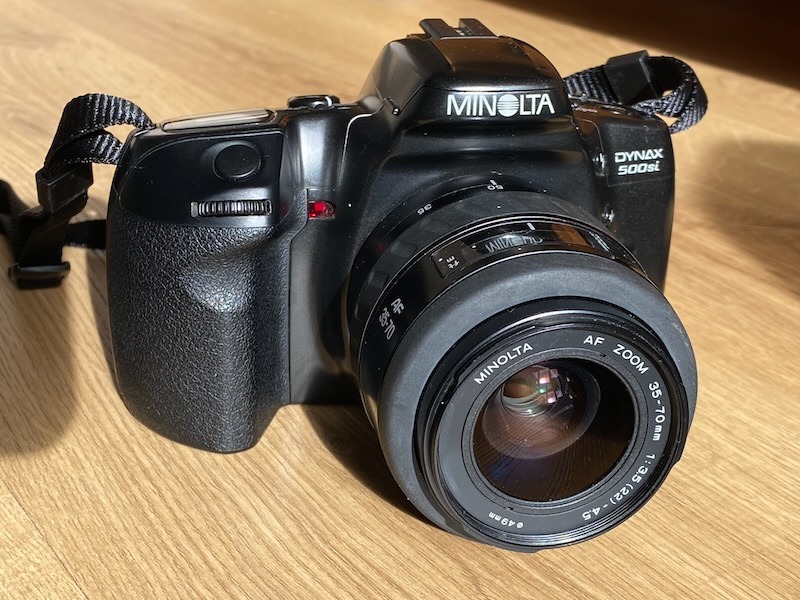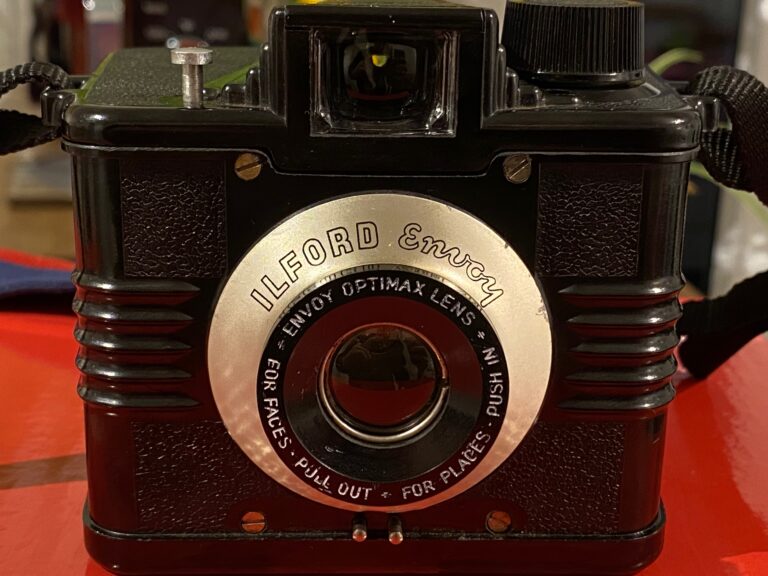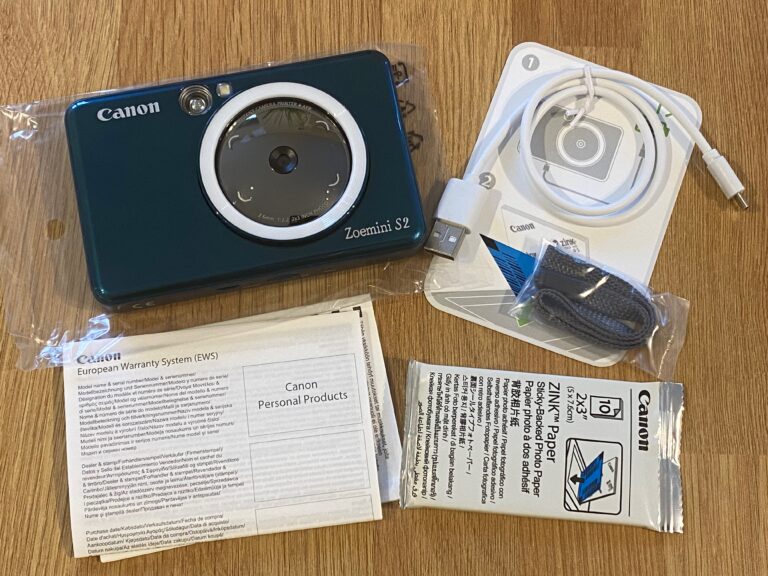I’ve recently been looking into cameras which hold some form of historical or technological significance. It turns out that there are other camera manufacturers out there that aren’t Canon? I know, I’m as shocked as you are by this revelation and apparently in the mid 1980’s a little known company called Minolta invented something called auto focus.
In all seriousness, Minolta were a huge deal in the 1980’s and early 1990’s. They’d stole a march on the whole market by inventing a really rather capable and usable auto focus system. If you read old camera magazines, you’ll notice that every single innovation ever was greeted with utter contempt by at least half of the magazine’s audience. The letters pages were ablaze with “real photographers don’t need this nonsense!” and “you’ll have to beat me half to death with a tripod before I give up my full manual controls.” I’m only slightly exaggerating – people seemingly despised change. The later onset of APS was met with the same derision and for Gods sake, don’t mention digital imaging.
In 1989, the Minolta Dynax 7000i was a big model and a contender for a place in many a camera bag. Up against the brand new Canon EOS 600 range and Nikon’s various offerings, it was highly regarded as an excellent and capable imaging tool. Minolta had updated the previous model the 7000 (no “i”) with a raft of welcome upgrades and some slightly more questionable additions. It seemed like a good place to start investigating this seminal era of AF film bodies, so I set out to pick up a copy – which I did.
However, the 7000i’s have not aged well due to a couple of choices Minolta made in terms of plastics and rubbers, so although I did fairly well winning one, I was on the lookout for another which might be in slightly better condition. This is when I completely accidentally bought the much later 500si and the story changes direction completely!
In this post:
An accidental purchase
How do you accidentally buy the wrong camera? Well, quite simply by not paying attention to what you’re doing. Moreover, not paying attention whilst you should still be doing your actual day job and just throwing in cursory bids whilst you remember an auction before going off to do something else. That’s exactly what happened here. This particular auction was extremely badly listed, it consisted of one very blurry picture and no description whatsoever. I added it to my watch list and forgot about it.
As an aside, I am stunned by the number of auctions today that contain blurry photos. With modern smartphones it is almost impossible to take a blurry photo any more, you can take pictures in near darkness and they still come out with remarkable quality – who are these people who can manage to break such a competent and well sorted system? What are they doing?!
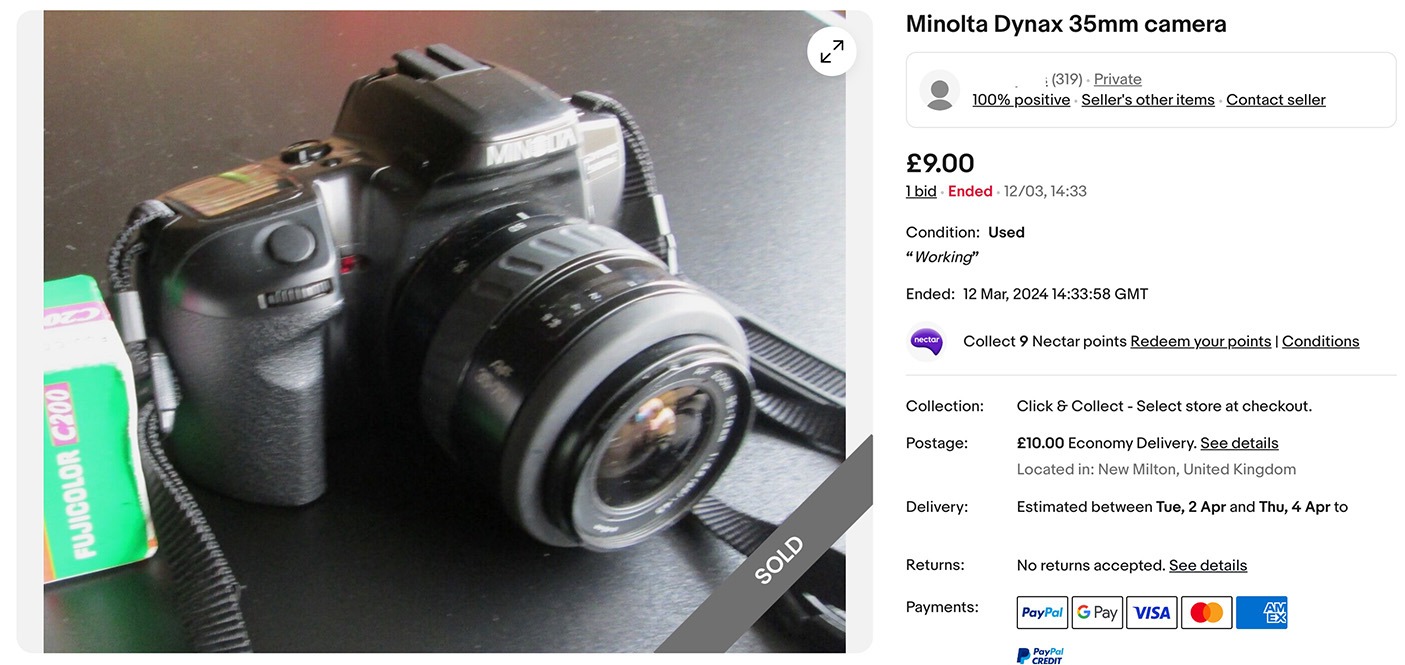
When the inevitable “auction ending soon” notification popped up, I looked at it, saw zero bids and £9 and put in a bid of the same amount and put my phone down again. I didn’t notice the £10 postage either, but I figured it would be worth it for spares and, failing that, another lens to use along with the 50mm Minolta mount lens I already had. Obviously, I won and a few days later a box large enough to fit a small child in arrived at my front door.
I was slightly baffled why such a small camera had arrived in an apparently over sized box – perhaps the owner worked at Amazon and enjoyed the competitions they apparently have to send the smallest items out in the largest boxes they can possibly find. Anyway, at least it didn’t look like an improvised explosive device wrapped in an entire roll of parcel tape which a seller had sent me an Olympus in some months earlier…
The reason for the massive box was that they had decided to ship the camera inside this:
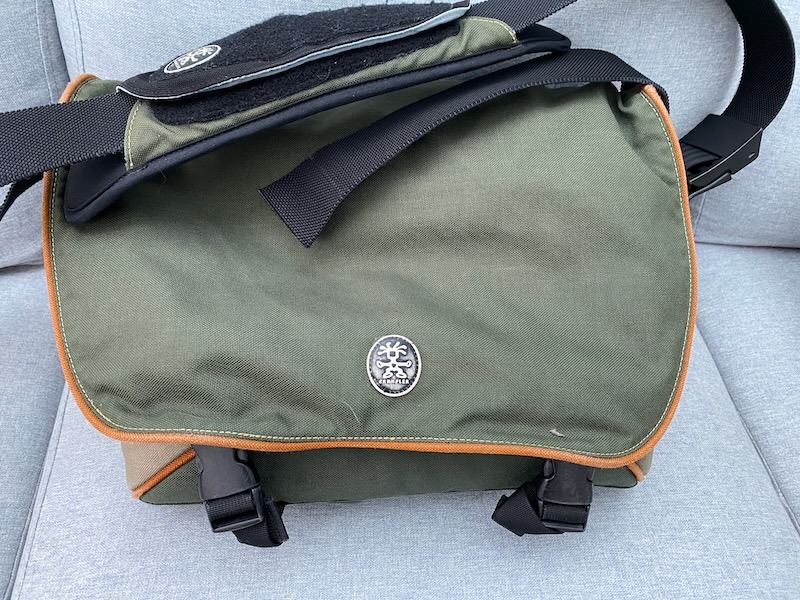
This is a courier bag made by a company called “Crumpler” and the model is called “Roll-O-Notes.” Whilst some research shows that this bag is now quite old, it is also a very expensive, well made and well regarded bag made out of robust and quality materials. The strap is thicker than the seatbelts in my car and probably stronger too. I shoved it round the washing machine to kill the stale, musty smell and, honestly, it’s a great camera bag – although it was designed for early 2000’s laptops that weighed and measured the same as a couple of dead badgers.
For protection, the seller had stuffed the bag with hundreds (and I mean that literally) and hundreds of council recycling bags. I now have enough clear plastic recycling bags to last me and the rest of the street for the remainder of our lives. Underneath all those bags was one very clean and quite happy looking Minolta 500si – a camera that I wasn’t expecting because… I’d bid on it without really looking properly. Still, I like a surprise now and again.
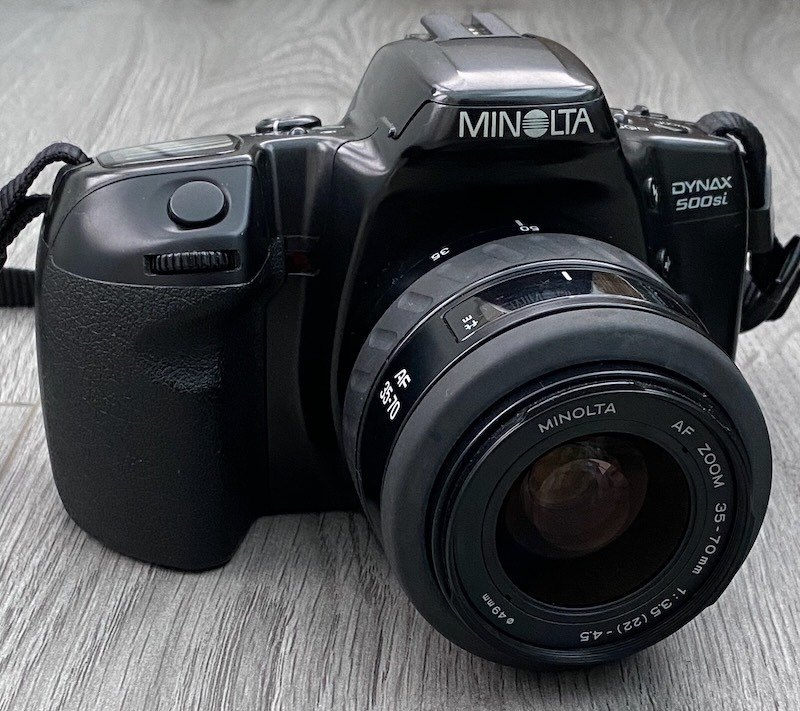
I did a quick battery test and put my test film inside and everything seemed just fine. The only problem now was… what to do with it? This wasn’t a camera that had been on my list of “cameras to sort.” I put it to one side and started to do some reading about early Minoltas and discovered this wasn’t early at all – it debuted in 1994 and was warmly received. This then sent me on a tangent of buying up boxes of old Amateur Photographer magazines so I could get some reviews, opinions adverts and the like. It was then that this paragraph caught my eye:
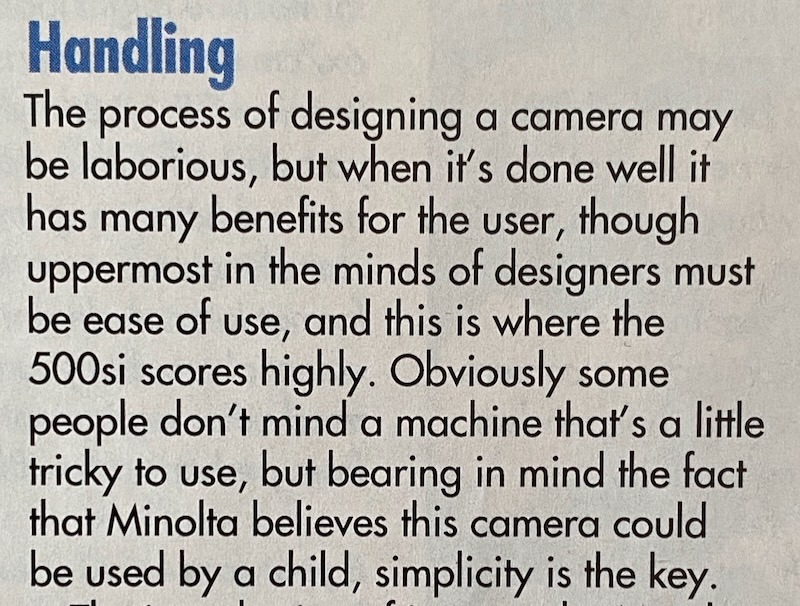
“Minolta believes this camera could be used by a child.” Well… I’ve got one of those! Why don’t we put this claim to the test? A quick conversation and one very excited six year old later and we had a purpose for this imaging machine once more.
Putting a 6 year old in charge
The brilliance of children is they have no concept of self consciousness, of socially accepted ideas or norms. They do not conform to photographic rules, composures or trends. They are full of wonderful innocence and a view of the world that you and I have long forgotten and regularly overlook. What is interesting to them, probably passes us by without a second thought. My intention with this camera was to show my daughter how to load a film, how to turn the camera on, what pressing the shutter button to focus and then fire felt like and that was it. Leave it in the default program mode with no rules, no guidance, no panicking if she shot 5 frames of her feet by accident. This was to be a roll of film purely guided by her and her ideas.
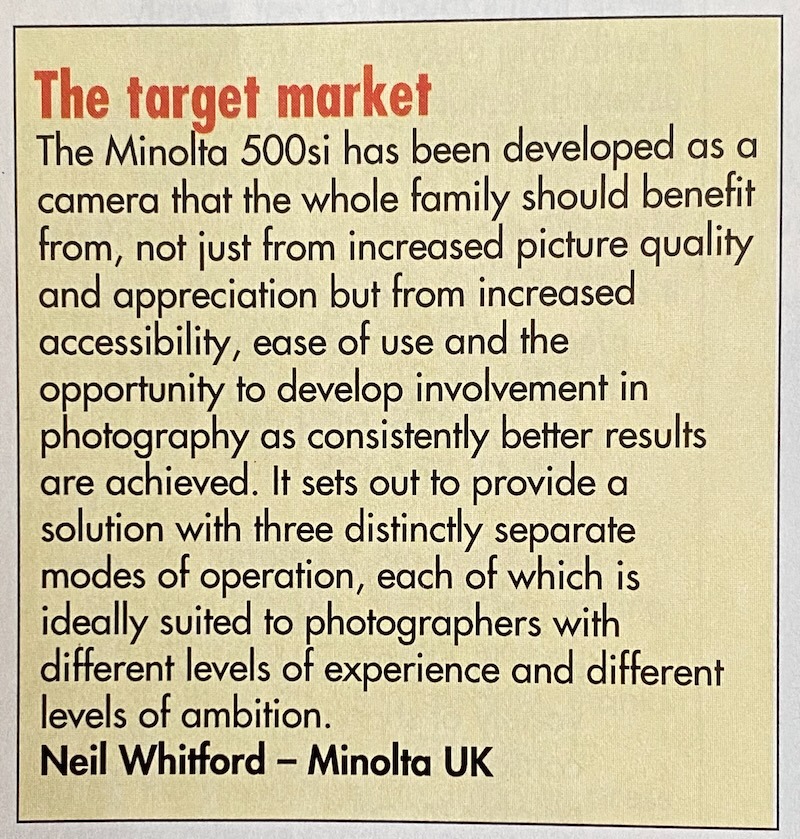
“Anyone. Literally anyone who will buy one. Buy one. Please.”
Neil doesn’t necessarily say “buy one for a six year old and let them run riot” but then… I doubt many did as it cost roughly £400 in 1994 for this camera kit with the lens, and that is approximately £800 in todays money. You’d have been a little on the nervous side thirty years ago, but now? For £9? No one cares. This is yet another joy of thrifty film photography. You can put the most powerful, capable toys of yesteryear in the hands of amateurs, children, whoever and it just doesn’t matter. Nothing rare or significant is going to be destroyed if an accident happens.
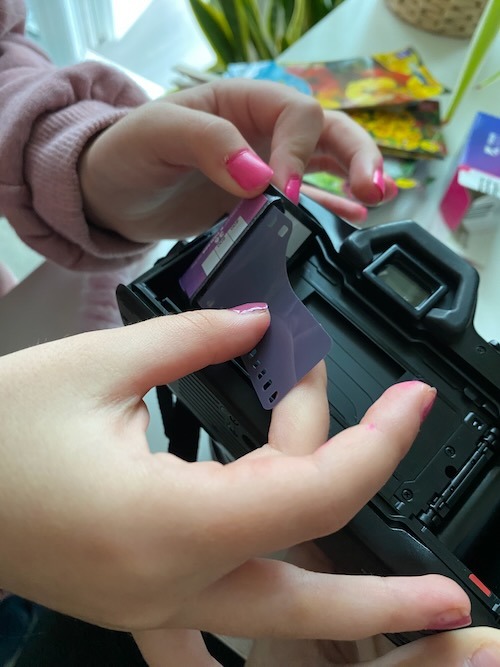 | 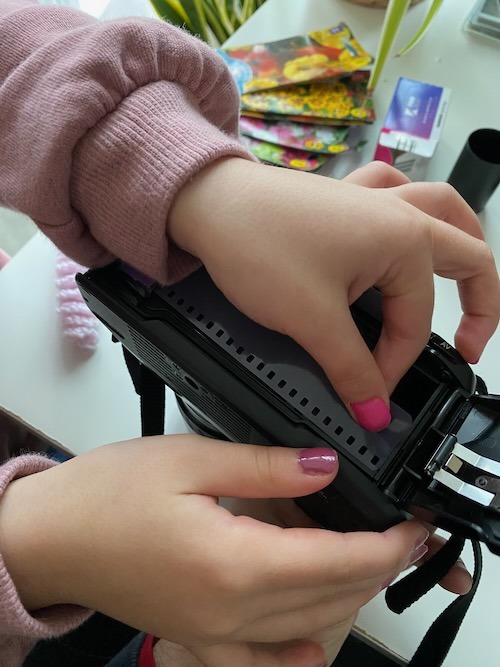 |
Learning to load film was simplicity itself. The only thing necessary to stress was that if too much film is pulled out then the first frame would be destroyed. Once the leader was drawn to the orange mark and door snapped shut the camera sprang to life making, what are to a six year old, fantastic and exciting noises. I think sometimes we forget how quiet technology has made our world – just think how angry and noisy PC’s sounded in the 90’s with floppy disks grunting and bumping along, hard drives constantly grinding away. Now your computer is silent. Back then, everything had an associated noise and I personally miss it – machines with character are much more interesting, let alone the fact you can actually predict and diagnose faults when things start to sound wrong.
What now?
“I want to take pictures of people!”
Fine by me…
How did it cope?
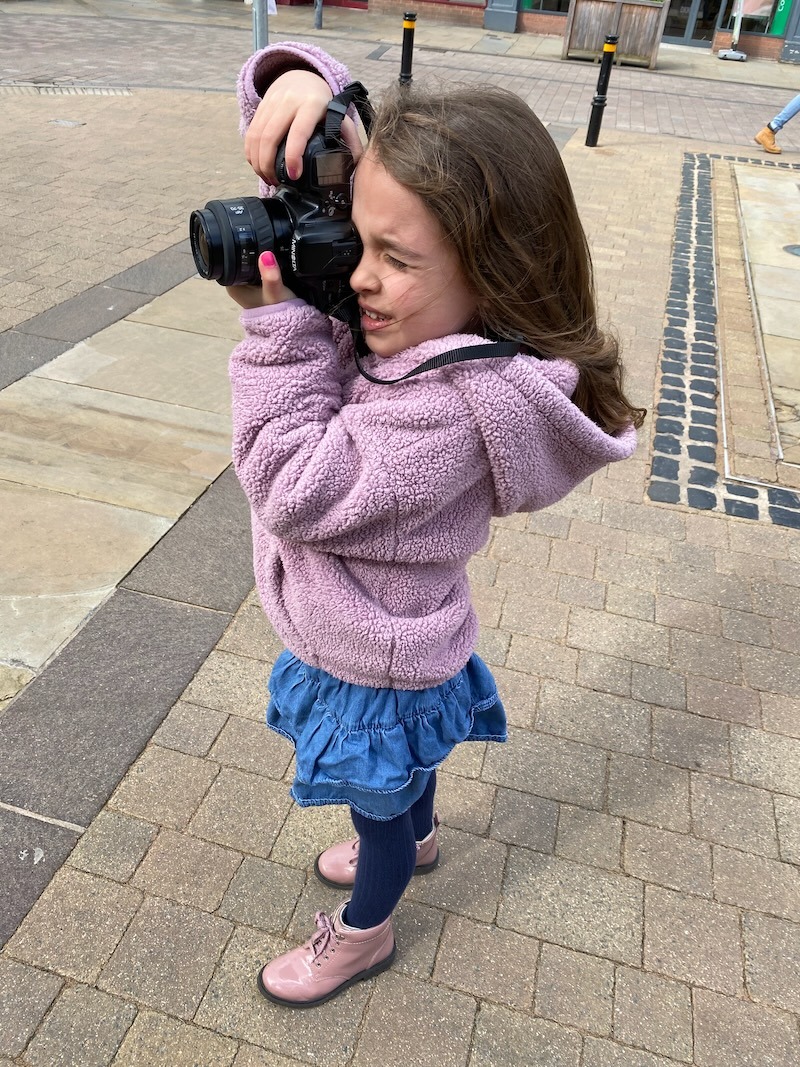
Over the course of two days she fired off 37 frames (the 500si seems to go until it feels resistance rather than hits a numerical limit) in two different locations. Unfortunately my Jobo daylight tank decided to let me down for the first time in over 17 years and I lost the last 4 frames as I thought the end of the film had been wound on to the spiral but it hadn’t. I’m still annoyed by that now but fortunately I think those frames would’ve been blurry anyway as they were taken indoors in very low light. Of those 37 frames, probably half were keepers in terms of being in focus or not suffering from camera shake. The film was Kentmere 400 developed in Rodinal. To keep things as authentic as possible, none of the pictures have been cropped, edited or changed other than removal of dust and some sharpening.

From observing the camera in use it appears that the program mode favours larger F stops rather than higher shutter speeds. It seemed to balance the shutter around 1/250th or thereabouts every time I could see the information on the LCD. A lot of the shots taken were at F8-11 which seemed a bit cautious in terms of depth of field. Personally, I would have preferred if the camera had erred on the side of higher shutter speeds but it was pretty consistent in choosing to stop down the lens instead.
Metering seemed to be pretty good. There were no pictures in this set where there was obvious over or under exposure and it did really well when pointed at vast quantities of sky, still managing to be intelligent enough to balance this out with the rest of the frame. If the program mode preferred slower shutter speeds, then it definitely biased the shadows rather than the highlights which isn’t a bad choice.

I’m not a fan of Kentmere film at all as I’ve only ever found that when developed in Rodinal it produces really quite visible grain along with the occasional inexplicable white dot here and there. I’m sure that with finer grain developer you could perhaps get better results but I don’t develop often enough to justify buying developer that will be expired by the next time I come to use it – Rodinal is king of shelf life. However, it was all I had in the fridge which had a DX code on the film can – all of my Foma film was in blank cans which had no dx code and the 500si refuses to take non-DX coded films and you cannot manually change the DX selected ISO.

Occasionally the camera would confuse her when it refused to fire although the shutter button was pressed. This is a built in feature of Minolta’s AF system – if it cannot achieve a focus on something then it will not fire at all until it either it has found something or you flick the manual focus switch. When being used by a child, this is both a good and bad feature. It’s great in that it removes one more reason why a shot might not come out, bad because they’re not expecting a lack of response.
As far as I can tell, all Minolta cameras from that era came with predictive AF meaning they would initially attempt a single shot focus and then monitor the scene for movement, at which point they’d switch to tracking AF mode. You cannot select these focus modes manually, it is what it is. I’d say there were probably 5-6 frames where the focus had clearly missed the intended subject. It’s difficult to say why definitively. All of the frames included moving people but when you’re not looking through the viewfinder yourself you can’t judge whether it was because the subject was off centre, moving too fast, whether the camera was moved before the shutter fired and a hundred other reasons.

I’d say, that for a mid-level, 1994 AF camera it performed pretty well. It’s important to remember that commercially, AF wasn’t even a decade old in 1994 and certainly nowhere near the level of AF you’d be used to now in even the most basic of cameras. This was second generation AF at best, but a pretty competent attempt.
There are no visual indications of focus points (it apparently uses some kind of multi zone system) in the viewfinder, the only indication you get is whether AF has locked on to a subject or not. That’s it.

What did we learn?
Did the 500si live up to Minolta’s claim? Yes. Yes it did.
Was this because Minolta made the worlds simplest, most intuitive SLR of the early 1990’s? No.
Unless you were there in the 1990’s with a passion for photography, or you’ve dug through endless publications as I have recently, it’s hard to describe how excited people and magazines were over very minor or seemingly obvious advances. One of them was the “pictograph” which is something I’ve discussed at length in my Canon T80 review. The 500si was lauded for “finally” jumping on the pictograph bandwagon to describe the various shifted program modes that could be used. Camera manufacturers took an actual generation to realise that perhaps ergonomics and usability mattered. As technology, minitauarisation, micro controllers and LCD displays caught up with the ambitions of designers they then had to learn how best to implement these technologies to achieve decent results.
Don’t forget the utter derision people had for these advances in technology. It’s very much akin to how upset people get about moving from manual to automatic cars. “How can a computer possibly know better than I do when to change gear?!” Well… I hate to break it to you… Camera manufacturers very much threw lots of spaghetti at the wall and stood back to work out what had stuck and why during this time.

The fact of the matter is that a child would definitely find difficulty with a manual camera from perhaps the early 1980s, but any camera with a program mode and auto focus essentially turns your big posh investment into a point and shoot camera. The truth is that program modes do an incredible job in about 80% of situations and even early cameras will make a decent attempt at working out an exposure that you can live with, do something with or wouldn’t notice there was anything wrong with.
Absolutely the program mode in the Minolta isn’t faultless and I do think that the shutter speeds should’ve been favoured over small apertures. Modern cameras will make this balancing act and indeed I noticed on the T90 and EOS 1, for example, they will often try to target approximately 1/500 as a starting point, with the EOS 1 showing further bias for higher shutter speeds with longer lenses.
So it isn’t that Minolta made a particularly revolutionary camera in terms of ease of use, they just released a body which contained a decent amount of automation in a well presented package. In terms of it being a camera suitable for children, it does have a few subtle ergonomic details that do help in small hands. The body is quite small for an early 90’s SLR and certainly lightweight. The fact it is almost 90% plastic really does help in this regard and little people really notice even this weight around their necks after a while of walking around.
I shall leave the final conclusions to my daughter:
“Did you enjoy using the camera?”
“Yes! It was brilliant!”
“Are you happy with the pictures? Do you have any favourites?”
“Yes, all of them!”
“Is there anything you think could be improved about the camera?”
“No.”
So there you go, Minolta, I think you’ve got a real hit on your hands with the 500si, you should start getting them in shops asap.
Share this post:

